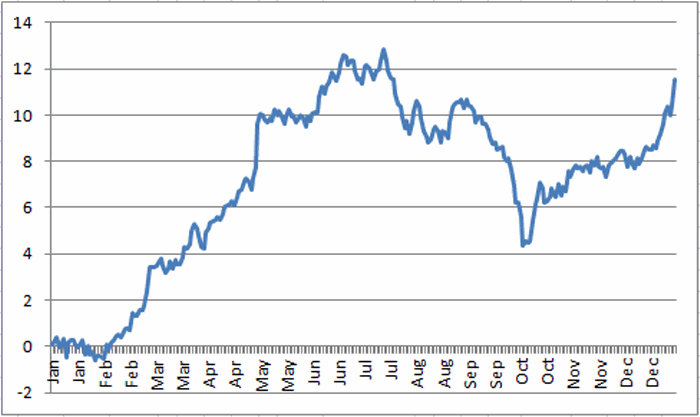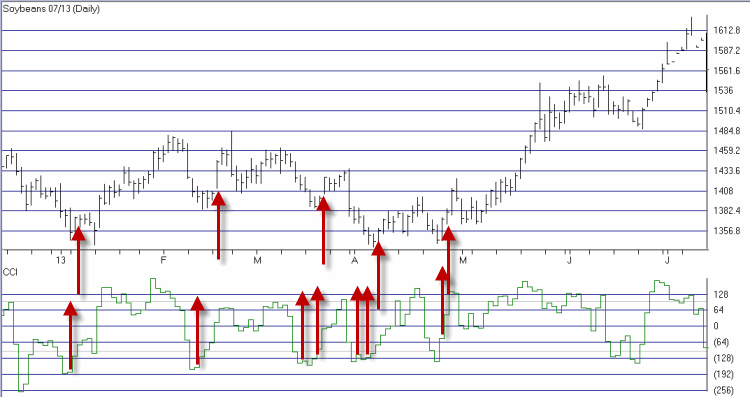Sure everyone is focused on the weather. Snow, sleet, freezing rain, brutal cold, etc. What’s coming next? How soon? How much more can I take!?
But all of this drama simply distracts us from the really important question – to speculators anyway – that being “How will all of this affect planting season?”
How soon will the snow melt? How long before the fields thaw? Will planting be hindered by any of this? Is this exciting stuff or what!? Well, in a way it is. Because it is when there are no soybeans (or corn for that matter) in the ground in the Midwest that the doubts are greatest about the crop for a given year. This often (typically?) has the effect of driving grain prices higher during late winter and into spring.
To wit, Figure 1 below displays an Annual Seasonal Trend Chart for soybeans since 1978. In a nutshell it displays the average performance for soybean prices over the course of an average year. Figure 1 – Annual Seasonal Trend Chart for soybeans
Figure 1 – Annual Seasonal Trend Chart for soybeans
Anything jump out at you? Anything at all?
Well just off the cuff it seems reasonable to state that bean prices have displayed a tendency to rise between early February and late July as well as from early October through year end.
On the flip side, early July into early August and late August into early October look like a pretty good time to consider the short side of the bean market.
Of course, this chart represents a composite of many years of price action, and the reality is that during any given year, soybean price fluctuations can vary significantly from what appears in Figure 1. So the idea of just buying soybean futures during the winter and holding on for months and waiting for the profits to roll in is not necessarily a wise game to play. Especially considering the leverage involved in futures trading (http://tinyurl.com/leeveb3).
A Trading Approach to Soybeans
What follows should not be considered a “system”, but rather just an “idea” of one way to consider playing soybeans during the typically favorable winter/spring/early summer seasonal period. Essentially, this method highlights a potential “entry method”, nothing more, nothing less. Before a trader could consider using something like this in real trading there are other questions to be asked and answered, such as:
*How much capital will I commit to futures trading?
*How much capital will I commit to one trade?
*How much risk am I willing to take on any one trade?
*How will I exit a trade with a profit?
*How will I exit a trade with a loss?
You know, all the “boring” stuff that too many traders don’t like to think too much about because its not as “sexy” as a “cool” market timing technique.
Anyway, the “entry rules” are essentially as follows:
-If today is between January 1st and May 15th
-If the CCI Indicator (Commodity Channel Index) drops below -120 and then ticks higher for one day
-Then buy the next time July soybeans exceed the previous trading day’s high.
-Place a stop-loss x points below the entry price (or the recent low or whatever – sorry folks, you need to do your own homework and figure out what your comfortable with on this one).
The other part of the equation is deciding when to close a trade with a profit. You can take a quick profit if it occurs, you can take a partial profit (if you are trading more than a 1-lot) and let the rest ride, you can take a partial profit and employ a trailing stop on the rest, and so on and so forth. (Like I said, I am just highlighting a potential entry technique, not spelling out a “soup to nuts” trading “system.”)
In Figure 2 we see July 2013 soybeans. The lower clip displays the occasions where the CCI ticked up after dropping below -120. The upper clip displays the days when beans took out the previous day’s high after a red arrow in the lower clip.  Figure 2 – July 2013 Soybean futures
Figure 2 – July 2013 Soybean futures
As you can see, a lot of things can happen after an “entry” signal:
-The market may just run higher and all you have to do is figure out when to take your profit.
-The market may move higher for a few days and then fall back, which argues for some sort of “selling into strength” profit-taking.
-The market may not move higher at all (so where exactly should that stop-loss be placed?)
Hence the reason it is essential to determine specific answers to the questions posed above before engaging in any actual trading.
Summary
Whether the “method” I have described here will lead to anyone generating trading profits depends on a number of variables. But remember the real point:
*We are in a seasonally favorable period for soybeans
*So we should be looking for buying opportunities
*A plan that includes money management and risk management is essential.
Jay Kaeppel

